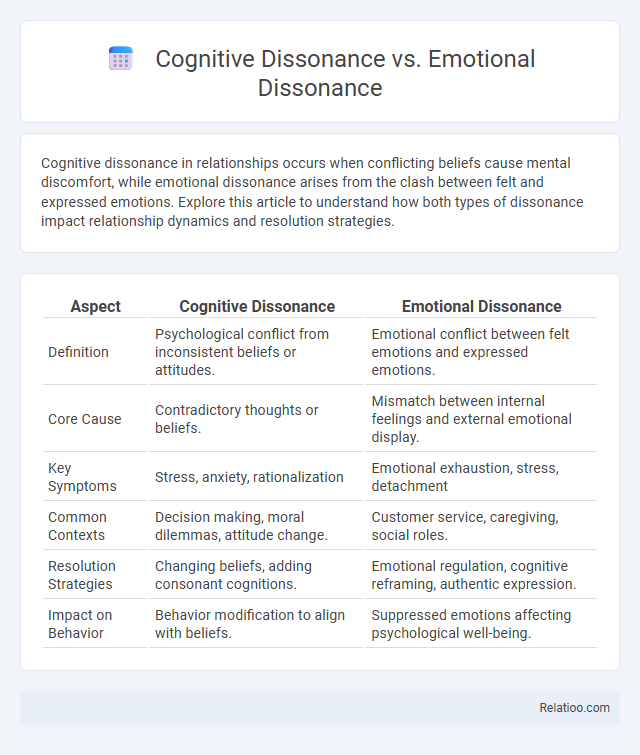Cognitive dissonance in relationships occurs when conflicting beliefs cause mental discomfort, while emotional dissonance arises from the clash between felt and expressed emotions. Explore this article to understand how both types of dissonance impact relationship dynamics and resolution strategies.
Table of Comparison
| Aspect | Cognitive Dissonance | Emotional Dissonance |
|---|---|---|
| Definition | Psychological conflict from inconsistent beliefs or attitudes. | Emotional conflict between felt emotions and expressed emotions. |
| Core Cause | Contradictory thoughts or beliefs. | Mismatch between internal feelings and external emotional display. |
| Key Symptoms | Stress, anxiety, rationalization | Emotional exhaustion, stress, detachment |
| Common Contexts | Decision making, moral dilemmas, attitude change. | Customer service, caregiving, social roles. |
| Resolution Strategies | Changing beliefs, adding consonant cognitions. | Emotional regulation, cognitive reframing, authentic expression. |
| Impact on Behavior | Behavior modification to align with beliefs. | Suppressed emotions affecting psychological well-being. |
Introduction to Cognitive and Emotional Dissonance
Cognitive dissonance refers to the mental discomfort experienced when an individual holds conflicting beliefs, attitudes, or values, leading to psychological tension. Emotional dissonance arises when there is a mismatch between felt emotions and emotions expressed outwardly, often occurring in professional or social settings requiring emotional regulation. Both cognitive and emotional dissonance impact decision-making, behavior, and emotional well-being, highlighting the complexity of human psychological processes.
Defining Cognitive Dissonance
Cognitive dissonance refers to the psychological discomfort experienced when an individual holds conflicting beliefs, attitudes, or values simultaneously, prompting efforts to reduce inconsistency. Emotional dissonance involves a disconnect between expressed emotions and actual feelings, often occurring in professional settings requiring emotional regulation. Dissonance, in a broader sense, denotes any tension or inconsistency between thoughts, feelings, or behaviors, with cognitive dissonance specifically emphasizing mental conflict and its resolution strategies.
Understanding Emotional Dissonance
Emotional dissonance occurs when there is a conflict between experienced emotions and emotions that must be displayed, often leading to stress and burnout in service-oriented professions. Unlike cognitive dissonance, which involves conflicting beliefs or attitudes, emotional dissonance specifically targets the regulation and expression of genuine feelings versus socially expected emotions. Understanding emotional dissonance is crucial for managing workplace well-being and improving emotional labor strategies.
Key Differences Between Cognitive and Emotional Dissonance
Cognitive dissonance refers to the mental discomfort experienced when a person holds conflicting beliefs or attitudes, prompting efforts to reduce inconsistency through attitude or behavior changes. Emotional dissonance involves the conflict between felt emotions and emotions expressed to conform to social or professional expectations, often leading to stress or burnout. The key difference lies in cognitive dissonance originating from conflicting thoughts or beliefs, whereas emotional dissonance stems from discrepancies between internal feelings and external emotional expressions.
Psychological Mechanisms Behind Each Dissonance
Cognitive dissonance arises when individuals experience conflicting beliefs or attitudes, triggering mental discomfort that motivates attitude or behavior change to restore consistency. Emotional dissonance occurs when there is a incongruence between experienced emotions and emotions expressed, often leading to psychological strain and stress, particularly in roles requiring emotional regulation such as customer service. General dissonance encapsulates the broader psychological mechanism of tension caused by inconsistency between thoughts, feelings, or behaviors, activating neural regions involved in conflict detection and resolution, including the anterior cingulate cortex.
Real-Life Examples of Cognitive Dissonance
Cognitive dissonance occurs when your beliefs conflict with your actions, such as continuing to smoke despite knowing the health risks. Emotional dissonance involves mismatched feelings and expressions, like maintaining a calm demeanor at work while feeling stressed inside. Real-life examples of cognitive dissonance include justifying procrastination by downplaying deadlines or rationalizing poor financial decisions despite knowing the consequences.
Situational Cases of Emotional Dissonance
Emotional dissonance occurs when Your genuine emotions conflict with expected emotional expressions, especially in service roles or caregiving environments, leading to stress and burnout. Cognitive dissonance involves holding contradictory beliefs or attitudes simultaneously, often motivating individuals to change their mindset to reduce discomfort. Unlike general dissonance, which refers to any inconsistency, emotional dissonance specifically arises from managing emotions that do not align with true feelings in professional or social situations.
Impact on Mental Health and Well-being
Cognitive dissonance arises when conflicting beliefs create psychological tension, leading to stress and anxiety that impair mental health and overall well-being. Emotional dissonance, experienced when individuals must display emotions inconsistent with their true feelings, often results in emotional exhaustion, burnout, and decreased psychological resilience. General dissonance disrupts emotional equilibrium and cognitive harmony, increasing vulnerability to mood disorders and negatively affecting mental wellness.
Coping Strategies for Dissonance
Cognitive dissonance involves the mental discomfort from holding conflicting beliefs, often managed by changing attitudes or seeking information that aligns with existing views. Emotional dissonance arises when individuals must hide true feelings while expressing required emotions, commonly addressed through emotion regulation techniques or social support. General dissonance coping strategies include rationalization, selective exposure to affirming information, and mindfulness practices to reduce psychological tension and restore internal harmony.
Conclusion: Managing Cognitive and Emotional Dissonance
Effective management of cognitive and emotional dissonance requires recognizing the mental and emotional conflicts that arise when beliefs, attitudes, or feelings clash with actions or experiences. You can reduce discomfort by aligning your thoughts with behaviors through strategies such as cognitive restructuring and emotional regulation techniques. Understanding these distinct forms of dissonance helps promote psychological well-being and decision-making clarity.

Infographic: Cognitive Dissonance vs Emotional Dissonance
 relatioo.com
relatioo.com